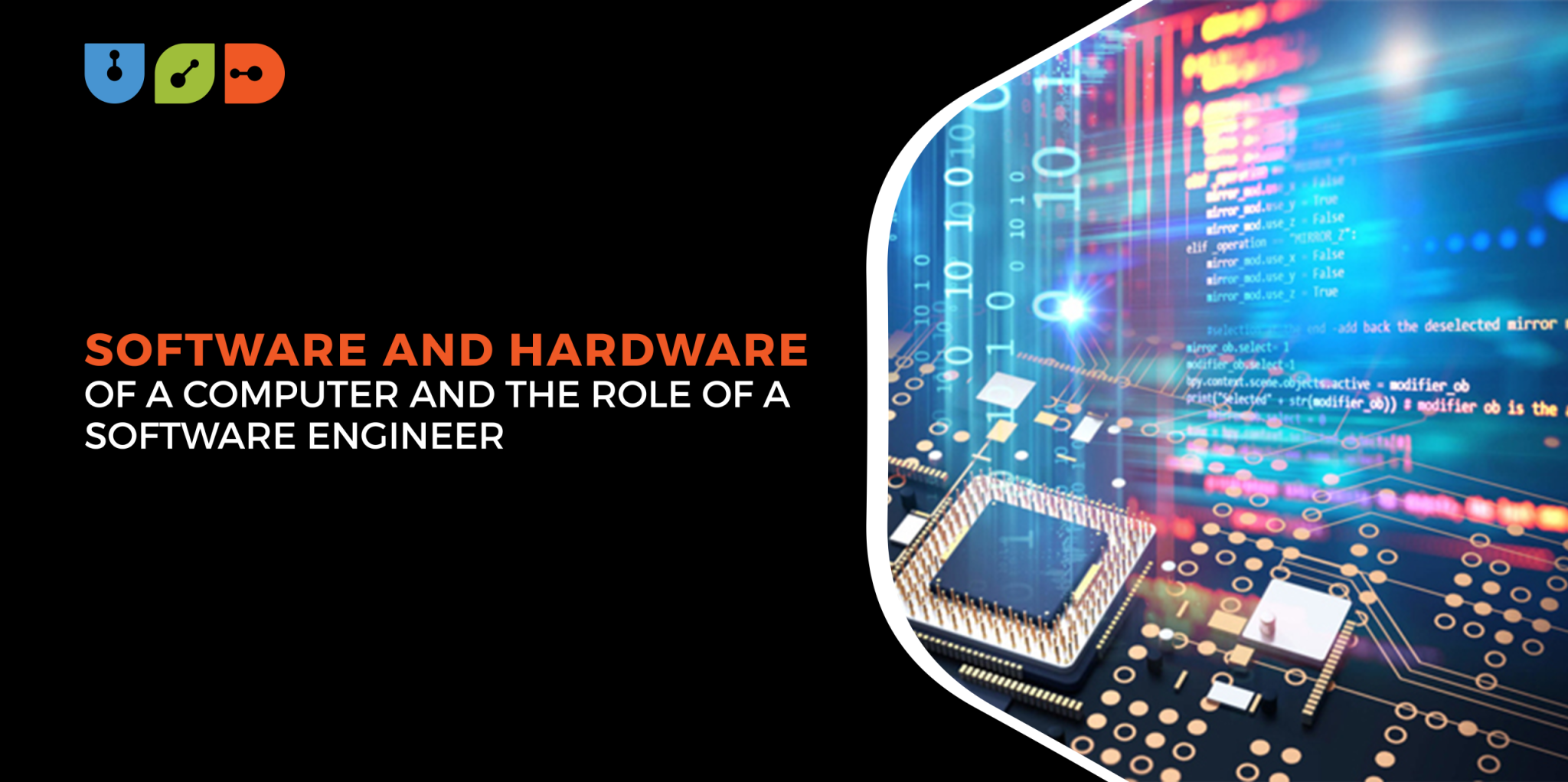Table of Contents
ToggleEven the Best Expert in a field was once a Novice Learner
Learning is a continual process, and there must not be any hesitation in asking even the most basic of questions. Although numerous channels and videos cover the latest technologies, the basic ones are losing the limelight. The hardware and software of a computer are the most vital pillars on which the most innovative technologies stand. So, we cover the numerous concerns and questions in this blog pertaining to hardware, software, engineers, and developers. Let’s begin with the definitions, components, and mutual collaboration of these fundamentals.
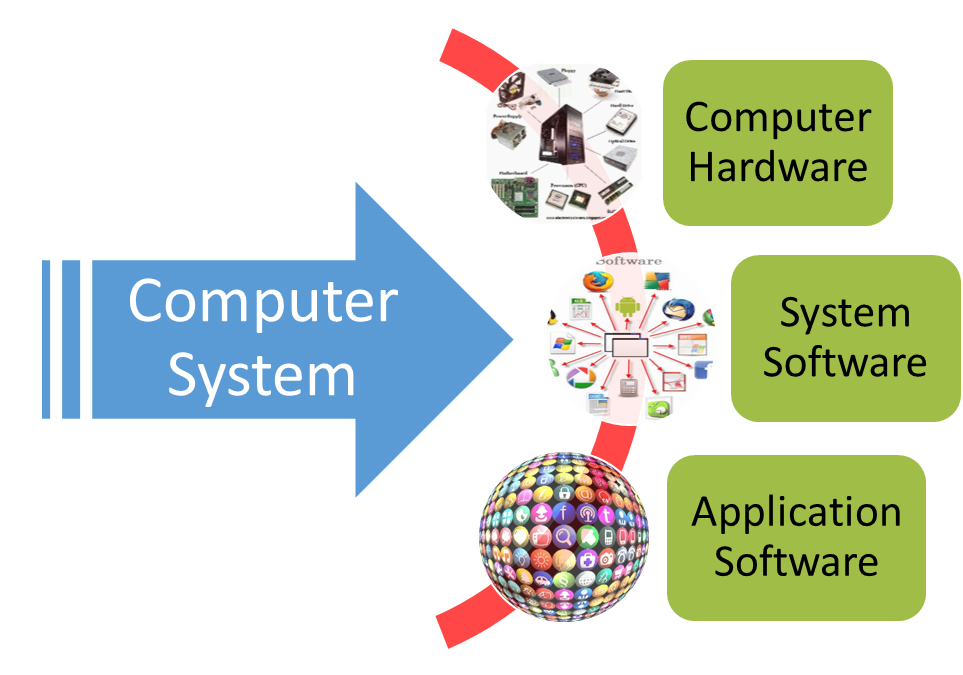
Software and Hardware of a Computer
Before we begin, let us identify the physical nature of the hardware, the intangible nature of software, and the link between them. If we open up a computer and fragment every part, we still don’t find any software. Why? Because it’s like the words we speak to communicate with people for what we need or want them to do.
A. What is Computer Hardware?
Computer hardware denotes the physical parts and devices that a computer system comprises. These tangible parts are essential for the functioning of a computer and rely on each other for processing and storing data. Computer hardware includes various components, each with its specific function. Here are the most common categories of computer hardware:
1. Central Processing Unit (CPU)
Acting as the brain of the computer, the CPU accomplishes tasks and carries out commands. It processes data and manages the overall operation of the computer.
2. Memory (RAM)
Random Access Memory (RAM) is a volatile memory used for temporarily storing data that the CPU needs for quick access. It allows the computer to retrieve and process information quickly.
3. Storage Devices
These devices are used for long-term data storage. Common types include Hard Disk Drives (HDDs), Solid State Drives (SSDs), and external storage devices like USB drives. They store the operating system, applications, and user data.
4. Motherboard
The main circuit board, or Motherboard, joins and facilitates collaboration between various hardware components. It houses the CPU, memory modules, storage devices, and other essential connectors.
5. Graphics Processing Unit (GPU)
The GPU, commonly known as a graphics card, renders images and videos. It is particularly crucial for graphics-intensive tasks, such as gaming, video editing, and graphic design.
6. Power Supply Unit (PSU)
The PSU converts electrical power from an outlet into a usable form for the computer. It supplies power to various components, ensuring the computer’s proper functioning.
7. Input Devices
Input devices aid interaction with the computer, even through motion control sensors. Common examples include keyboards, mice, touchscreens, and consoles that users rely on.
8. Output Devices
Output devices display information processed by the computer. Examples include monitors (display screens), printers, and audio speakers.
9. Networking Hardware
Components such as network interface cards (NICs) and routers enable computers to connect to networks, including local area networks (LANs) or the Internet.
10. Peripheral Devices
These additional devices enhance the functionality of a computer. Examples include printers, scanners, webcams, and external drives.
11. Cooling Systems
To prevent overheating, computers use cooling systems such as fans or liquid cooling solutions. These components dissipate heat generated during the CPU or other hardware operations.
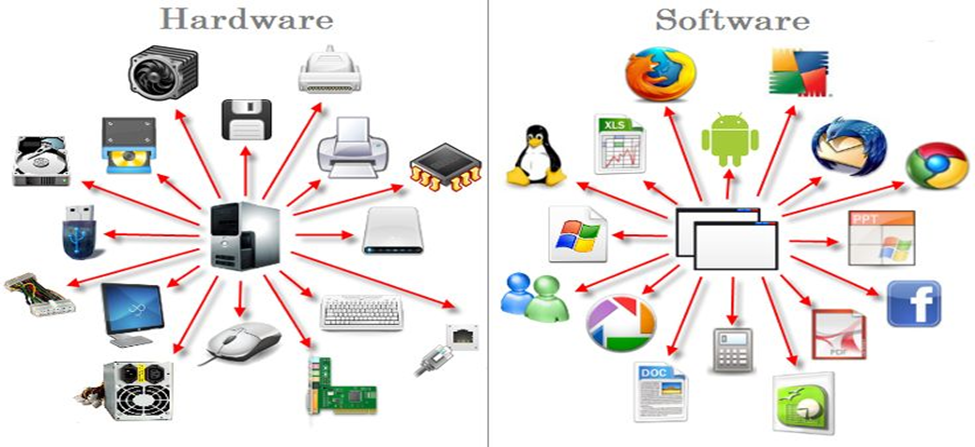
B. What is Software?
Software refers to a set of instructions, programs, or data that enable a computer or a computing device to perform specific tasks or operations. It is the intangible counterpart to hardware, which governs the physical components of a computer system. Software provides the functionality and capabilities that make computers useful for various applications. The first two are the main categories of software, while the rest are categories on the basis of distribution and usage.
1. System Software
Operating Systems (OS): The software responsible for managing hardware or other software resources via a user interface. Examples include Microsoft Windows, macOS, Linux, and Android.
Device Drivers: Driver software bridges the communication between an operating system and hardware devices such as printers, graphics cards, and storage devices.
2. Application Software
Productivity Software: Tools that help users create, edit, and manage documents, spreadsheets, or presentations. Examples include Microsoft Office (Word, Excel, PowerPoint) and Google apps.
Media and Entertainment Software: Applications for playing music and videos, editing photos and videos, or gaming. Examples include Adobe Creative Suite, VLC Media Player, and games.
Web Browsers: Software used to access and interact with websites on the Internet. Examples include Google Chrome, Mozilla Firefox, and Microsoft Edge.
Utilities: Programs that perform specific tasks to maintain or optimize system performance. A few examples are antivirus systems, file compression, or disk cleanup tools.
3. Proprietary Software
A company usually develops and distributes such software with a license that restricts how to use, modify, and distribute it. Users typically need to pay for proprietary software with partial or no access to the source code.
4. Open-Source Software
These are released with a license that allows users to view, modify, and distribute the source code freely. Open-source software is often collaboratively developed, and users can contribute improvements or modifications.
5. Freeware
It is available for free, often with basic functions. Users can use freeware without paying but may not have access to the source code.
6. Shareware
Similar to freeware, users can pay for the full version to access additional features or remove limitations. Shareware is typically available on a trial basis, which mostly expires after some time.
7. Commercial Software
A company develops and sells commercial software to its customers. Commercial software may be proprietary or open-source, but users must typically purchase a license to use the full version.

C. What Lets the Computer’s Hardware and Software Work Together?
The essential component that enables computer hardware and software to work together is the operating system (OS). The operating system serves as the intermediary between the hardware components and the software applications, facilitating coordination to perform tasks. Here’s how the operating system facilitates the interaction between hardware and software:
1. Hardware Abstraction Layer
The operating system provides a layer of abstraction over the hardware components. This abstraction hides the complexity of hardware details from software applications. Instead of direct interaction, applications make requests to the operating system, which translates requests into desirable actions from the hardware.
2. Device Drivers
Device drivers are special programs within the operating system that allow software applications to communicate with specific hardware devices. When an application needs to interact with a printer, graphics card, or any other peripheral, it sends requests to the operating system. The OS, in turn, uses the appropriate device driver to communicate with the hardware for tasks.
3. Resource Management
The operating system is responsible for managing the computer’s resources, including CPU, RAM, storage, and input/output devices. It allocates resources as per the needs of running applications, ensuring efficient utilization and preventing conflicts between different software components.
4. Process and Memory Management
The operating system oversees the execution of processes, which are instances of running programs. It allocates memory to these processes and manages the switching between them, assigning each process the necessary resources to perform.
5. File System
The operating system provides a file system that organizes and manages data on storage devices. Applications interact with files through the file system, allowing them to create, read, or modify data. The file system abstracts the details of the underlying storage hardware.
6. User Interface
The operating system provides a user interface (display) through which users can interact with the computer. This interface can be graphical (GUI) or textual (command-line). Users initiate actions, and the OS translates these commands into operations for the hardware and software.
7. System Services
The OS provides various system services that software applications leverage. These services include networking functions, communication between processes, and support for background processes that run independently of user interactions.
D. How Does Software Interact with Hardware?
The interaction between software and hardware is facilitated by the operating system, which acts as an intermediary layer. This interaction involves several key components and processes.
- When a user runs an application, it sends requests to the OS, specifying desirable actions.
- The OS provides a set of services and abstractions for software to interact with hardware.
- Applications make a system call to the OS for a specific service or operation from it.
- If apps make a system call for a specific hardware, the OS uses its device driver to interact.
- Abstraction hides the details of hardware for a standard interface to application software.
- Applications request memory from the OS, which in turn assigns the necessary resources.
- The OS oversees the execution of processes, reflecting running instances of programs.
- It manages process scheduling, allowing multiple applications to share the CPU efficiently.
- The OS provides a file system that organizes and manages data stored on storage devices.
- It manages input and output processes, letting apps interact with peripheral devices.
- The OS also provides a user interface through which users interact with the computer.
The Role of a Software Engineer
Whether developing a system software or an application software, the role of a software engineer is central to the endeavor. Let’s analyze what is a software engineer, what they do, and how to become one.
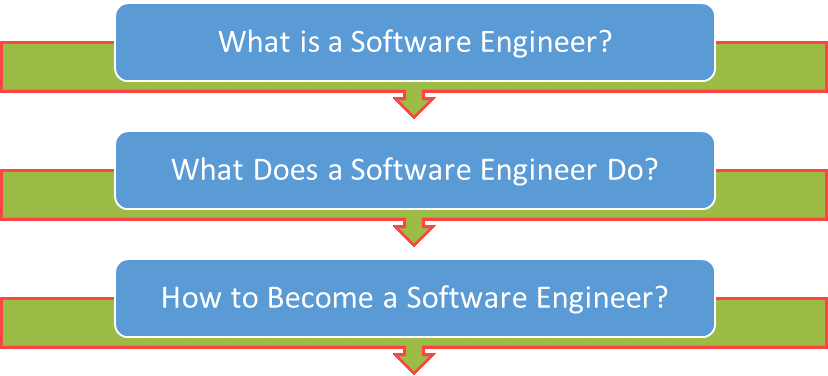
A. What is a Software Engineer?
A software engineer is a professional who applies engineering principles to the design, development, testing, and maintenance of software systems. Software engineers are involved in creating software solutions that address specific needs, solve problems, or improve efficiency in various domains. Key aspects of a software engineer’s role include
1. Software Development
Writing code to create software applications, systems, APIs, or components. It involves using programming languages, development frameworks, and tools to translate requirements into functional software.
2. System Design
Planning and designing the architecture of software systems. It includes defining the structure of the software specifying components, modules, interfaces, and data flow to meet the project requirements.
3. Testing and Debugging
Conducting thorough testing of software to identify and fix bugs, errors, and issues. Software engineers use various testing methodologies to ensure the reliability and functionality of the software.
4. Collaboration
Collaborating with cross-functional teams, including product managers, designers, quality assurance engineers, and other stakeholders, to understand requirements and deliver high-quality software solutions.
5. Problem-Solving
Analyzing problems, assessing user needs, and developing innovative solutions. Software engineers use critical thinking and problem-solving skills to address challenges and optimize software performance.
6. Maintenance and Updates
Providing ongoing support for software systems by troubleshooting issues, implementing updates, and ensuring that software remains secure and compatible with evolving technologies.
7. Documentation
Creating documentation for software projects, including technical specifications, user manuals, and code documentation. It helps in knowledge transfer, maintenance, and collaboration among team members.
8. Continuous Learning
Staying updated on emerging technologies, programming languages, and industry best practices. Software engineers often engage in continuous learning to adapt to evolving trends and enhance their skills.
9. Project Management
Planning and managing software development projects, including setting timelines, allocating resources, and coordinating tasks. Project management skills are crucial for delivering software solutions on time and within budget.
10. Ethical Considerations
Adhering to ethical standards and considering the societal impact of software. It includes addressing issues related to privacy, security, and the responsible use of technology.
B. What Does a Software Engineer Do?
A software engineer performs a wide range of tasks throughout the software development lifecycle, from initial concept to deployment and maintenance. The specific responsibilities may vary depending on the organization, the project, and their role within a development team. Here are key aspects of what a software engineer commonly does:
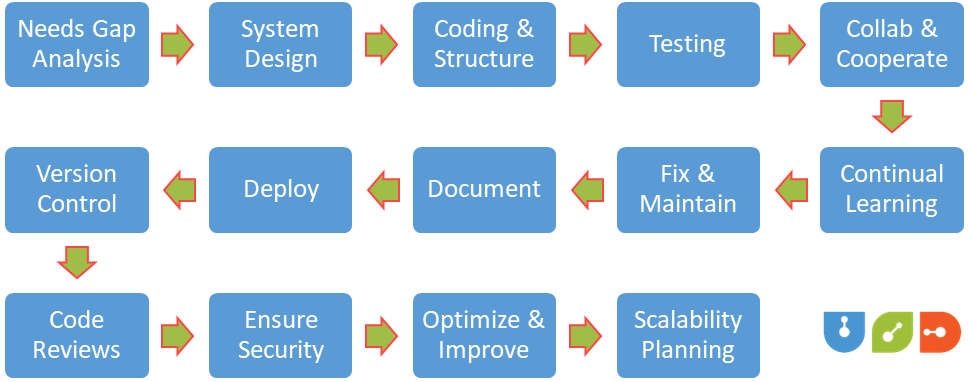
1. Requirement Analysis
Collaborate with stakeholders, including product managers and end-users, to gather and understand the requirements for the software project. It involves identifying functionalities, features, and user expectations.
2. System Design
Create an intricate design and architecture for the software system as per client requirements. Define the structure of the software, including components, modules, and data flow.
3. Coding and Structure
Write, test, and maintain code to develop software applications. Software engineers use programming languages and development frameworks to implement the designed system, ensuring adherence to coding standards and best practices.
4. Testing
Conduct various types of testing, including unit testing, integration testing, and system testing, to identify and fix bugs and ensure the software functions correctly. Software engineers may also contribute to the development of automated testing procedures.
5. Collaboration
Work closely with cross-functional teams, such as product managers, designers, quality assurance engineers, and other developers. Effective communication and collaboration are essential to understanding project requirements and delivering cohesive solutions.
6. Version Control
Use version control systems like GitHub or GitLab to manage and track changes to the source code. It ensures that multiple developers can collaborate seamlessly and revert to previous versions if needed.
7. Deployment
Assist in deploying the software to production environments. It involves coordinating with system administrators and DevOps teams to ensure a smooth transition from development to live deployment.
8. Documentation
Create documentation for various aspects of the software, including technical specifications, code documentation, and user manuals. Clear and comprehensive documentation helps in understanding, maintaining, and troubleshooting the software.
9. Bug Fixing and Maintenance
Respond to and address issues reported by users or discovered during testing. Regularly update and maintain the software to ensure it remains secure, stable, and compatible with evolving technologies.
10. Continuous Learning
Stay vigilant of the latest technologies, programming languages, and industry trends. Continuous learning is crucial for software engineers to adapt to advancements and improve their skills.
11. Code Reviews
Participate in code reviews with team members to ensure code quality, identify potential improvements, and maintain a consistent coding style. Study how to become a coder.
12. Security Considerations
Implement security best practices to protect software systems from vulnerabilities. Software engineers must be mindful of potential security risks and incorporate measures to secure data and prevent unauthorized access.
13. Performance Optimization
Optimize system performance by removing code errors to ensure efficient use of resources. It may involve identifying bottlenecks, improving algorithms, or making adjustments to enhance overall software performance.
14. Scalability Planning
Consider scalability factors when designing and developing software to accommodate future growth and increased demand. It involves anticipating and addressing potential scalability challenges.
C. How to Become a Software Engineer?
Becoming a software engineer involves a combination of education, practical experience, and continuous learning. Here is a step-by-step guide to help you become a software engineer:

1. Educational Background
Obtain a relevant educational background, usually a bachelor’s degree in computer science, software engineering, or a related field. Some positions may require or prefer a master’s degree, but a bachelor’s degree is generally sufficient to start a career.
2. Develop Programming Skills
Learn programming languages commonly used in software development. Popular languages include Python, Java, JavaScript, C++, and others. Focus on understanding fundamental programming concepts, data structures, and algorithms.
3. Build a Strong Foundation in Mathematics
Mathematics is integral to computer science. Develop a solid understanding of mathematical concepts, especially those related to algorithms, logic, and discrete mathematics.
4. Engage in Personal Projects
Create your software projects to apply your programming skills and build a portfolio. It could be developing a web app or website, building a mobile app, contributing to open-source projects, or creating software that solves a specific problem.
5. Participate in Coding Challenges
Take part in coding challenges on different platforms like HackerRank and LeetCode. They help improve problem-solving skills and expose you to a variety of algorithmic problems.
6. Pursue Internships or Co-op Positions
Seek internships or co-op positions to gain practical, hands-on experience in a professional setting. It provides exposure to real-world projects and enhances your understanding of industry practices.
7. Earn Certifications
Consider earning relevant certifications to demonstrate your expertise. Certifications from reputable organizations can enhance your resume and validate your skills in specific technologies or frameworks.
8. Attain Higher Degrees
Pursue a master’s degree in computer science or a related field if you aim for specialized roles or leadership positions. Advanced degrees can also open doors to research and development opportunities.
9. Stay Updated on Industry Trends
Keep abreast of the latest advancements in the field by following industry blogs, attending conferences, and participating in online communities. Stay informed about emerging technologies, tools, and best practices.
10. Develop Soft Skills
Enhance your communication and collaboration skills. Software engineers often work in teams, and effective communication is essential for project success. Soft skills like critical thinking, problem-solving, and flexibility are equally important.
11. Build a Professional Network
Attend industry events, meetups, and networking gatherings to connect with professionals in the field. Building a strong professional network can provide valuable insights, mentorship, and potential job opportunities.
12. Create a Strong Resume and Portfolio
Craft a resume that reflects your education, skills, and experience suitably for the job. Create a portfolio showcasing your projects, code samples, and any contributions to open-source projects.
13. Apply for Entry-Level Positions
Start applying for entry-level software engineer jobs. Look for openings that encourage learning new skills. Be prepared for technical interviews that assess your problem-solving abilities and coding skills.
14. Ace Technical Interviews
Prepare for technical interviews by practicing coding problems, reviewing algorithms and data structures, and understanding common interview questions. Demonstrate your problem-solving process and effective communication during interviews.
15. Continuous Learning
Embrace a mindset of continuous learning. The field of software engineering evolves rapidly, and staying updated on new technologies and development trends is crucial for long-term success.
D. Software Developer vs Software Engineer
| Software Developer | Software Engineer |
| Focus on Coding | Focus on Overall SDLC |
| Delivering on Requirements | System Design & Architecture |
| Proficiency in Programming | Engineering Principles |
| Project Execution | Collaboration with Teams |
| Problem-Solving | Incorporate Best Practices |
The terms “software developer” and “software engineer” are often used interchangeably, and the distinction between them can vary depending on the industry, company, or region. In many cases, there is no strict difference, and the titles may be used synonymously. However, in some contexts, there might be subtle distinctions in their roles. Here’s a general overview of their roles:
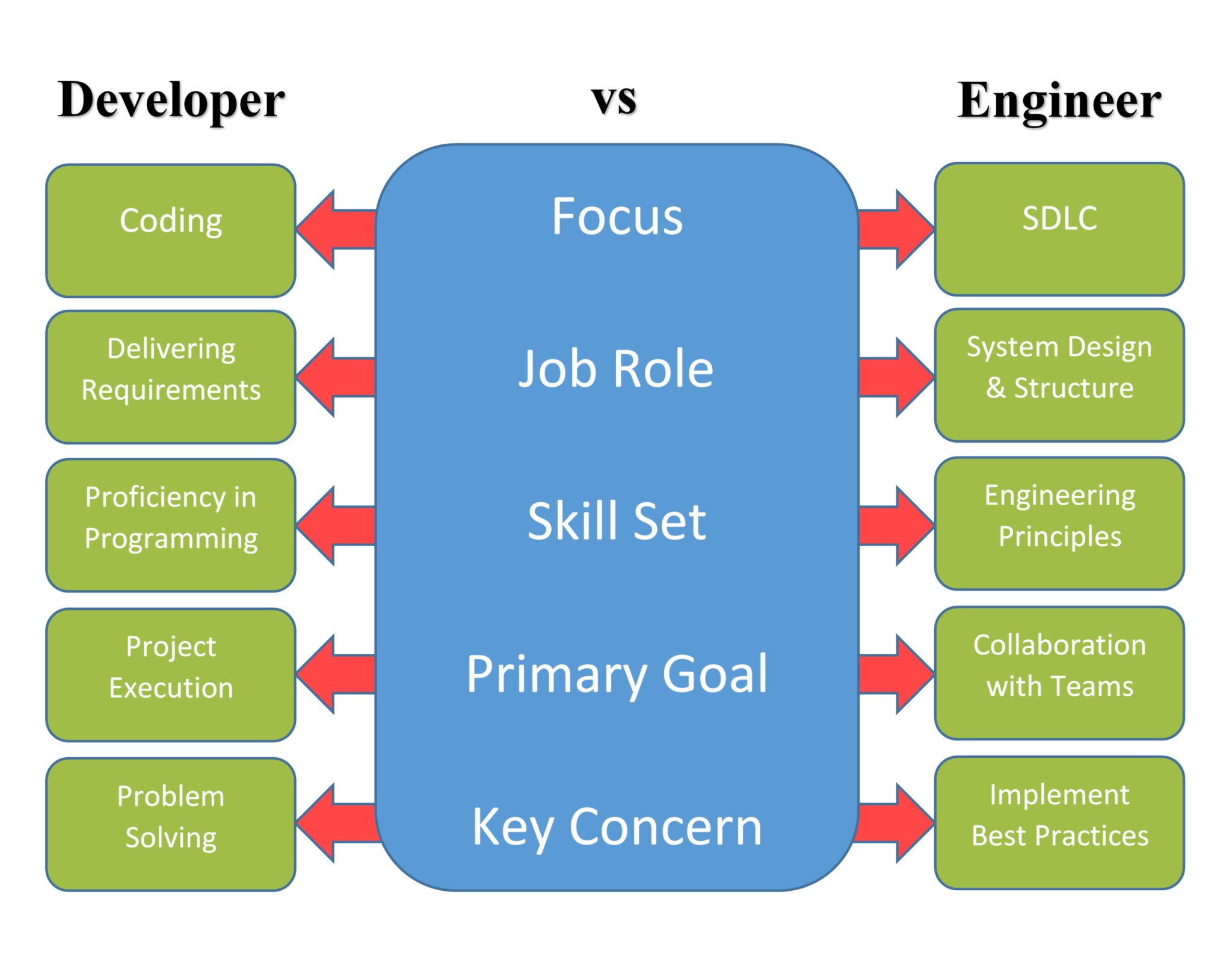
1. Software Developer
a) Focus on Coding
Software developers typically focus on coding and implementing software solutions. They are heavily involved in the programming aspect of software development.
b) Delivering on Requirements
Developers often work closely with project managers, analysts, and clients to understand the software requirements. Their primary responsibility is to translate these requirements into functional code.
c) Hands-On Coding Skills
Software developers are expected to have strong hands-on coding skills and proficiency in programming languages. They may work across various stages of the development process, from initial design to implementation.
d) Project Execution
Developers play a key role in the execution phase of a project. They write code, create software components, and contribute to the overall development of the application or system.
e) Problem-Solving
Problem-solving is a crucial aspect of a developer’s role. They need to address challenges related to coding, debugging, and ensuring that the software functions as intended.
2. Software Engineer
a) System Design and Architecture
Software engineers often have a broader role that extends beyond coding. They are involved in system design, architecture, and the high-level planning of software projects.
b) Engineering Principles
They apply engineering principles and follow best practices in the software development process. It includes factors such as scalability, reliability, and system integration while designing solutions.
c) Focus on Full Lifecycle
Software engineers are typically involved in the full software development lifecycle, from initial concept and design to testing, deployment, and maintenance.
d) Collaboration and Communication
Engineers often engage in collaboration with various stakeholders, including project managers, system architects, and clients. Effective communication and a holistic understanding of the project are important.
e) Incorporating Best Practices
Software engineers are more likely to focus on best practices, design patterns, and architectural considerations. They aim to create software that not only meets current requirements but is also scalable, maintainable, and adaptable to future needs.
E. How to Become a Software Developer?
Becoming a software developer also involves a combination of learning, experience, and constant improvements. Here are step-by-step guidelines to help you become a software developer:
- Obtain a bachelor’s degree in computer science, software engineering, or a related field.
- Cultivate expertise in programming languages that are highly in demand.
- Study basic data structures, algorithms, databases, and software design principles.
- Gain hands-on experience by working on coding projects or creating personal projects.
- Familiarize with web development technologies, including HTML, CSS, and JavaScript.
- Learn development tools such as version control systems, IDEs, and collaborative tools.
- Deeply understand popular software development methodologies like Agile and Scrum.
- Seek apprenticeships or junior positions to gain practical experience.
- Develop effective communication, problem-solving, and team-player skills.
- Create a portfolio showcasing your coding projects, contributions, and relevant work.
- Keep abreast of the latest tech stack and development trends in the software industry.
- Attend meetups, events, and conferences to connect with the developers’ community.
- Start applying for software development positions once you feel confident in your skills.
- Embrace a mindset of continuous learning as the field is rapidly evolving.
- Seek specialization in mobile app development, machine learning, or cloud computing.
Conclusion
No matter where you start your learning journey, becoming an expert takes time, and persistence is the key to success. Mentorship is essential in such journeys where you seek expert guidance and assistance. Unique Software Development has a vision of community development and societal improvement through constant support and services.
The first section of this blog explains the software and hardware of a computer with its components and collaboration. In addition, the second section explains the role of a software engineer, what they do, and how to become one. Moreover, we also analyze the software engineer vs software developer debate and how to become the latter. Keep pushing your boundaries in your quest for learning and growth, as those who never quit eventually win.

